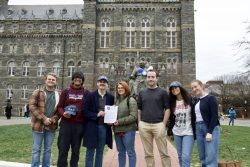After a relaxing Thanksgiving weekend at home, Dan Haney (SFS ’10) planned to coast into D.C. at 10:10 on Sunday night aboard a comfortable Amtrak train. But after two delays in Philadelphia, waiting for an hour in Wilmington, Del. when his train broke down and traveling at half-speed for the rest of the trip, Haney arrived at Union Station at 2:30 in the morning—over four hours late. Unfortunately, Amtrak—which served 24.3 million passengers in between June 2006 and June 2007—doesn’t always live up to expectations.
The federal government should increase Amtrak’s funding in order to give train travel, one of the safest, greenest forms of public transportation, the jolt it needs to become an efficient and reliable transportation option. Amtrak has long been underfunded, and though probably few of those 24.3 million passengers faced delays as bad as Haney’s, they all experienced the effects of a rail system struggling after years of neglect.
The Senate recently passed the bipartisan bill Passenger Rail Investment and Improvement Act, which would provide $11.4 billion over 6 years to Amtrak. Though it doesn’t address the long-term problems preventing Amtrak from becoming an optimally functional passenger rail system, the bill would provide funding desperately needed to improve Amtrak’s outdated infrastructure. Worn-out cars and machinery would be replaced, including transmission cables dating from the 1930s in Baltimore’s tunnels. The extra cash will also make up the difference between revenue and operating costs for Amtrak. The House of Representatives should pass the same bill, and President Bush should sign it into law.
Opponents of the bill—including President Bush, who is threatening a veto—want Amtrak to become financially self-sufficient. In FY 2006, Amtrak covered 67 percent of its operating expenses, but to expect it to operate without subsidies is foolhardy at best.
“You cannot get a passenger rail service, as we’ve seen throughout the world, that can operate without some form of subsidies,” Senator Frank Lautenberg (D-NJ) said on the Diane Rehm show. The government subsidized air travel and highways to the tune of $55 billion in 2007, so critics should hardly complain about the $1.3 billion Amtrak received or expect the company to be economically self-sufficient.
Increased subsidies will not only help repair Amtrak’s crumbling infrastructure; they will also help lower its exorbitant prices. A regular Amtrak ticket to New York on December 20 will run you $98, and the high-speed Acela train costs $188. By contrast, a JetBlue plane ticket for the same day is only $69.
Eventually, Congress must consider building Amtrak its own tracks. Amtrak currently shares tracks with commuter and freight trains operating at full capacity. If the U.S. wants to have a successful train system on par with those in Japan, Germany or Switzerland, just to name a few, then the U.S. government will have to make it financially feasible.




